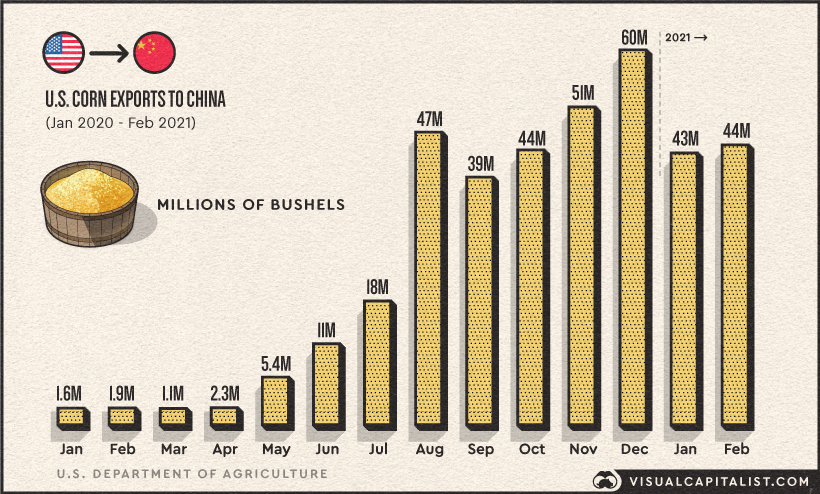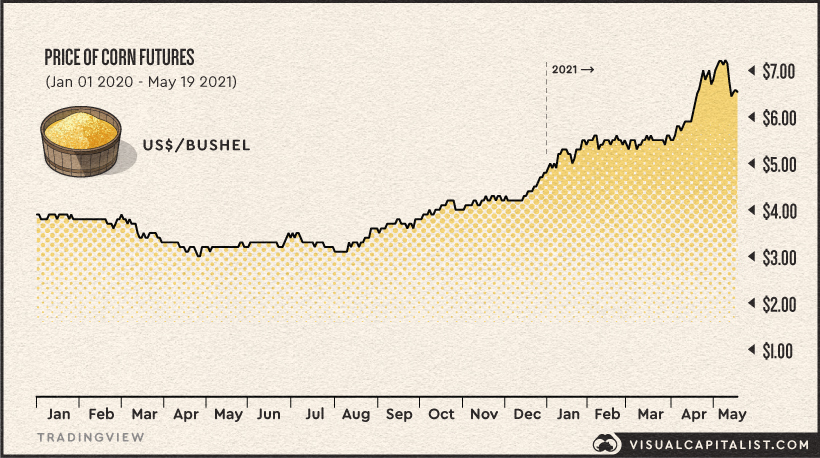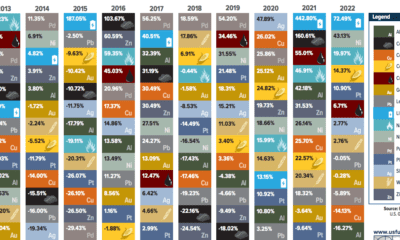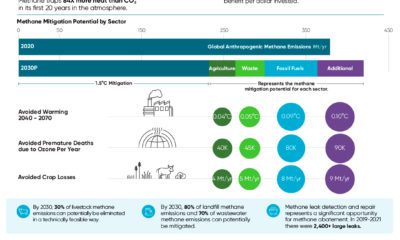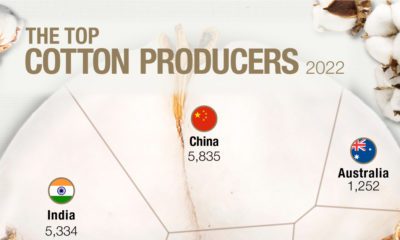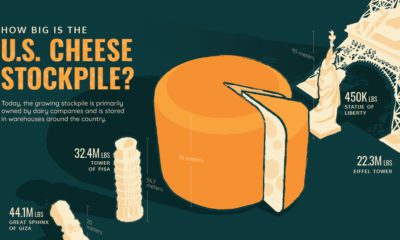From the sweetener in our coffees to the ethanol that powers our vehicles, corn has hundreds of uses. Consequently, high corn prices have a domino effect that can affect many supply chains and possibly even increase the cost of our weekly groceries, especially if they include tortilla chips.
This infographic uses data from the National Corn Growers Association to break down U.S. corn use by segment in 2020, and the products that a bushel of corn can produce.
The Uses of Corn in the U.S.
While corn on the cob is quite popular, not all corn is sweet. There are five major types of corn grown around the world, and each one differs in taste and uses. Of these, yellow dent corn or field corn accounts for the majority of commercial U.S. production. Here’s a breakdown of U.S. corn usage in 2020: Corn accounts for more than 96% of U.S. feed grain use and production. As a result, animal feed makes up nearly 40% of the country’s corn usage. This is because corn is a rich source of carbohydrates, and in combination with protein from soybeans, it can make for an effective diet for livestock. In the United States, federal mandates require vehicles to use a blend of gasoline and biofuels like ethanol—94% of which is produced from the starch in corn grain. Therefore, a large portion of U.S. corn goes into ethanol production. Interestingly, the ethanol distillation process produces a co-product known as dried distillers grain, which serves as low-cost, protein-rich animal feed for livestock. On average, the U.S. ethanol industry produces around 90,000 tons of distillers grains each week. Animal feed and ethanol production collectively make up around 73% of U.S. corn usage. Other uses of corn include the production of sweeteners, starch, cereal, and alcoholic beverages like whiskey.
Breaking Down U.S. Corn Exports
The U.S. is the world’s largest producer and exporter of corn and accounted for roughly 36% of exports in 2020. Up until 2019, the majority of U.S. corn exports went to Mexico, Japan, and Colombia. China wasn’t among the top 10 destinations, but this changed in 2020.
Between January 2020 and 2021, U.S. corn exports to China increased exponentially, reaching an all-time high in December. China’s massive import appetite is because of a shortage of domestic supplies amid rising demand for feed from its recovering hog-herd, which was hit by the African swine fever in 2018. Consequently, China became the third-largest importer of U.S. corn in 2020 after Mexico and Brazil. What’s more, the U.S. Department of Agriculture projects that China’s corn imports in 2021 will be much higher than 2020 levels, and the majority of those will be sourced from the United States.
The Corn Price Boom
In addition to a drought-induced yield cut in Brazil, rising demand from China has driven corn prices to their highest level in the last eight years.
Since the beginning of 2020, corn prices have increased 68% and stand at around $6.50 per bushel as of May 19th. The rise in corn prices is likely to affect several industries and could translate into higher prices for our groceries, including cereals, taco shells, and corn syrups. Additionally, it could also push up the price of gas due to its key role in ethanol production.
Corn, in a Bushel
In a world where commodities like corn are often taken for granted, it’s important to think about how valuable it can be. A single bushel of corn can provide 33 lbs of sweetener, 31.5 lbs of starch, or 22.4 lbs of polymers. It’s also enough to produce around 3 gallons of ethanol fuel and 16 lbs of distillers dried grains for animal feed. The uses of corn go far beyond the cob, and just like other raw materials, it supports many industries that make modern life possible. on Over recent decades, farmers have been able to more than double their production of crops thanks to fertilizers and the vital nutrients they contain. When crops are harvested, the essential nutrients are taken away with them to the dining table, resulting in the depletion of these nutrients in the soil. To replenish these nutrients, fertilizers are needed, and the cycle continues. The above infographic by Brazil Potash shows the role that each macronutrient plays in growing healthy, high-yielding crops.
Food for Growth
Nitrogen, phosphorus, and potassium (NPK) are three primary macronutrients that are the building blocks of the global fertilizer industry. Each plays a key role in plant nutrition and promoting crop growth with higher yields. Let’s take a look at how each macronutrient affects plant growth. If crops lack NPK macronutrients, they become vulnerable to various stresses caused by weather conditions, pests, and diseases. Therefore, it is crucial to maintain a balance of all three macronutrients for the production of healthy, high-yielding crops.
The Importance of Fertilizers
Humans identified the importance of using fertilizers, such as manure, to nourish crops dating back to nearly 6,000 to 2,400 BC. As agriculture became more intensive and large-scale, farmers began to experiment with different types of fertilizers. Today advanced chemical fertilizers are used across the globe to enhance global crop production. There are a myriad of factors that affect soil type, and so the farmable land must have a healthy balance of all three macronutrients to support high-yielding, healthy crops. Consequently, arable land around the world varies in the amount and type of fertilizer it needs. Fertilizers play an integral role in strengthening food security, and a supply of locally available fertilizer is needed in supporting global food systems in an ever-growing world. Brazil is one of the largest exporters of agricultural goods in the world. However, the country is vulnerable as it relies on importing more than 95% of its potash to support crop growth. Brazil Potash is developing a new potash project in Brazil to ensure a stable domestic source of this nutrient-rich fertilizer critical for global food security. Click here to learn more about fertilizer and food production in Brazil.
